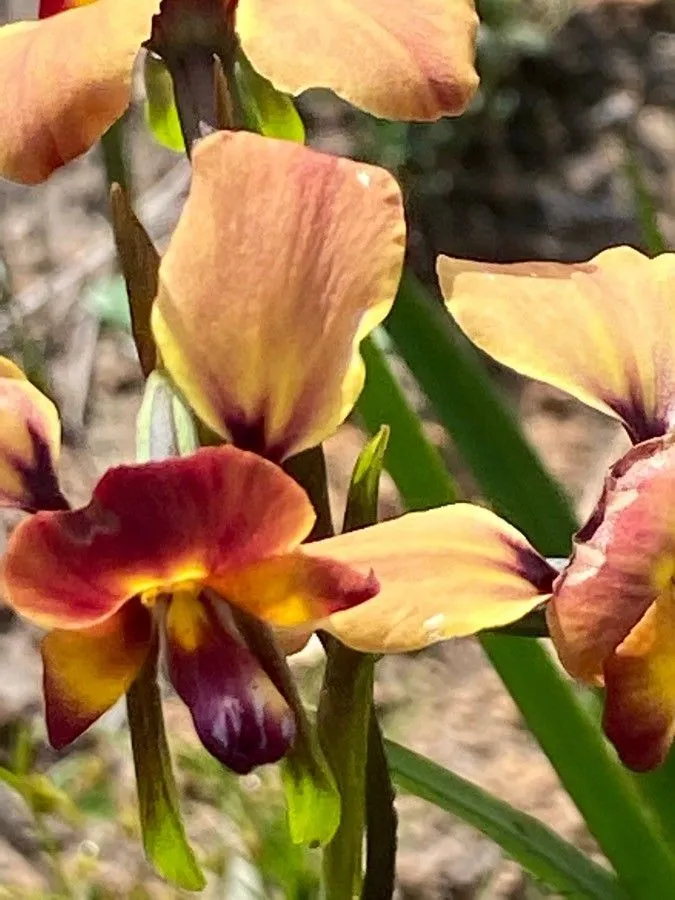
Author: D.L.Jones
Bibliography: Austral. Orchid Res. 3: 77 (1998)
Year: 1998
Status: accepted
Rank: species
Genus: Diuris
Vegetable: False
Observations: SE. Australia
The Wallflower orchid, known scientifically as Diuris orientis, is a striking and vibrant species native to Southeastern Australia. This beautiful orchid is a member of the Orchidaceae family, one of the most diverse and widespread families of flowering plants.
Commonly recognized for its distinctive and vivid flowers, the Wallflower orchid boasts bright and cheerful colors that resemble the familiar garden wallflowers. Each blossom appears as a delightful display of nature’s artistry, with intricate patterns and rich hues ranging from deep yellows to purples and oranges. The vibrant petals form an alluring contrast against their natural grassy habitats, making these orchids an appealing spectacle.
Diuris orientis typically thrives in a variety of environments across Southeastern Australia, from woodlands to open grasslands. This adaptability makes it an excellent representative of the resilience and diversity found within the region’s flora. The orchid flourishes in habitats that provide adequate sunlight, well-drained soils, and favorable climatic conditions, contributing to its widespread occurrence within its native range.
The unique morphology of the Wallflower orchid is particularly fascinating. It features a tuberous root system that allows it to store nutrients and survive through varying seasonal conditions. The slender stems support a cluster of flowers that bloom during the spring, adding a burst of color to the landscape. These floral arrangements are not just visually appealing; they also play a significant role in the ecosystem by attracting pollinators such as bees and insects, ensuring the plant’s reproduction and the continuation of its species.
First described by renowned botanist D.L. Jones in the authoritative text Austral. Orchid Res. 3: 77 (1998), Diuris orientis has since garnered considerable interest from botanists, horticulturists, and nature enthusiasts. Its captivating appearance and ecological significance offer insight into the rich biodiversity of Australian orchids and underline the importance of conserving these delicate species amidst ever-changing environmental challenges.
In conclusion, the Wallflower orchid, Diuris orientis, stands as a brilliant example of nature’s creativity, offering both aesthetic pleasure and ecological value. Its presence in Southeastern Australia is a testament to the beauty and complexity of the region’s plant life, continuing to inspire admiration and study among those who encounter it.
En: Wallflower orchid, Donkey orchid, Wallflower Donkey Orchid
Taken Jul 21, 2022 by Michal Svit (cc-by-sa)
Taken Dec 30, 2020 by Georgia Pope (cc-by-sa)
Taken Dec 30, 2020 by Georgia Pope (cc-by-sa)
Family: Myrtaceae Author: (F.Muell.) K.D.Hill & L.A.S.Johnson Bibliography: Telopea 6: 402 (1995) Year: 1995 Status:…
Family: Rubiaceae Author: Pierre ex A.Froehner Bibliography: Notizbl. Bot. Gart. Berlin-Dahlem 1: 237 (1897) Year:…
Family: Sapindaceae Author: Koidz. Bibliography: J. Coll. Sci. Imp. Univ. Tokyo 32(1): 38 (1911) Year:…
Family: Asteraceae Author: A.Gray Bibliography: Pacif. Railr. Rep.: 107 (1857) Year: 1857 Status: accepted Rank:…
Family: Fabaceae Author: Medik. Bibliography: Vorles. Churpfälz. Phys.-Ökon. Ges. 2: 398 (1787) Year: 1787 Status:…
Family: Aspleniaceae Author: (Cav.) Alston Bibliography: Bull. Misc. Inform. Kew 1932: 309 (1932) Year: 1932…